The perpetrators

Wilhelm Dreimann (1904-1946) was deployed by the state police to guard the Neuengamme concentration camp in 1940. He carried out executions in the camp with his own hands. He was referred to by prisoners as the executioner of Neuengamme. According to Johann Frahm (see below), he hanged at least the first two children and, together with Heinrich Wiehagen and Johann Frahm, also the adult prisoners.
He was sentenced to death in the Curio-Haus trial and executed on October 8, 1946.
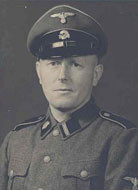
Johann Frahm (1901-1946) was trained as a guard at Sachsenhausen concentration camp in 1939. The concentration camp served as a so-called training camp for later concentration camp commanders and other surveillance personnel during the National Socialist regime.
From November 1942, Johann Frahm was on duty at Neuengamme concentration camp, from 1944 under Rapportführer Dreimann in the camp typing pool. He was involved in the murder of children and adult prisoners.
In May 1945, he was able to flee to his family in Kleve.
At the end of October 1945, he was arrested by British investigators and sentenced to death for the murders at Bullenhuser Damm in the Curio-Haus trial in 1946. He was executed on October 11.

Kurt Heißmeyer (1905-1967) was a doctor in Hohenlychen and wanted to become a professor. When he was deployed as a camp doctor for "medical" experiments in the Neuengamme concentration camp, he injected the 20 children with tubercle bacilli and operated on the lymph glands under their arms. The children developed high fevers and were in pain. Heißmeyer wanted to use the human experiments to prove that tuberculosis could be combated by artificially producing skin tuberculosis and that "racially inferior" people were more susceptible to tuberculosis. Heißmeyer's first thesis was already known among experts to be scientifically untenable long before the experiments. The second thesis was based solely on the racist and anti-Semitic ideology of the National Socialists.
In 1945, Heißmeyer buried a tin box containing various documents and objects in the garden of the Hohenlychen SS sanatorium, which the Allies were not supposed to find. In addition to private photos, the box contained medical records and photographs of the children on whom he had carried out experiments. He went into hiding in the GDR and was able to practise as a doctor there for another twenty years. After an anonymous letter to the Ministry for State Security, which mentioned his involvement and activity as an SS doctor in Neuengamme, no action was initially ordered. Kurt Heißmeyer was only arrested in 1963 and sentenced to life imprisonment for crimes against humanity by the Magdeburg District Court in 1966. Former prisoners of the Neuengamme concentration camp and former prisoner doctors testified against him, and the documents from the box he had buried himself also helped to reconstruct the crimes committed by Heißmeyer. In 1966, he was sentenced to life imprisonment for "crimes against humanity". Kurt Heißmeyer died in prison in 1967.
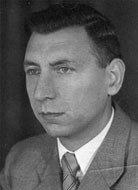
Ewald Jauch (1902-1946) joined the NSDAP in February 1932 and became a member of the SS two years later. From 1940-1944, Jauch was first employed as a guard and later as a Rapportführer at Neuengamme concentration camp. From December 1944, he was camp leader in the Bullenhuser Damm satellite camp, where he was involved in the murder of the children in April 1945. Ewald Jauch was sentenced to death during the Curio-Haus trial in 1946.
Ewald Jauch was born in Schwenningen am Neckar in 1902. After elementary school, he completed an apprenticeship as a merchant. Together with his wife Else, he also ran the "Schützenhaus" restaurant with several shooting ranges. The marriage produced three sons. According to his own account, Jauch lost his job due to a shoddy business transaction and was unemployed from 1931 to 1933.
Ewald Jauch joined the NSDAP as early as 1932 and became a member of the SS with the rank of Oberscharführer in 1933. Jauch's early membership of the party made him one of the old fighters and he was given a 25% job as a tax collector for the town of Schwenningen. Jauch always referred to this early membership whenever he asked for a salary. After training, including at the SS recreation home in Lochen near Balingen, he was called up to reinforce the SS Death's Head units in 1938.
As early as November 1939, Jauch was called up by Heinrich Himmler and stationed as Oberscharführer in the 9th Totenkopf Regiment in Danzig/Poland. His regiment was involved in persecution, shootings and the guarding of Jewish ghettos and concentration camps in Eastern Europe. There he tried in vain to be exempted from frontline service. Despite repeated requests, his release was refused, he injured his leg during a military exercise and was transferred to the Neuengamme concentration camp on April 20, 1940 as a Rapportführer.
After several assignments in the Darß satellite camp near Stralsund and Schandaleh, Jauch became head of the Bullenhuser Damm satellite camp in December 1945, where he was involved in the murder of the children in April 1945.
After the end of the war, Jauch fled to Schwenningen and hid in his parents' house until the British military police arrested him there. Jauch was imprisoned in the "Eselheide" internment camp of the British Army of the Rhine in Paderborn. In "Neuengamme Camp Case No. 3" from July 24 to 31, 1946, Ewald Jauch stood before the British military court for the murders at the Curiohaus trial. Ewald Jauch tried in vain to exonerate himself by referring to his leg injury. Ewald Jauch is sentenced to death and executed in Hamelin prison on October 11, 1946, where he is also buried.
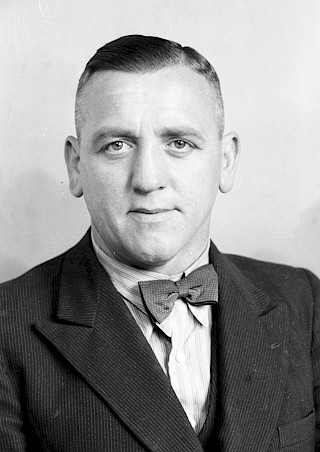
Max Pauly (1907-1946) from Wesselburen in Dithmarschen worked as a retail salesman. He joined the NSDAP in 1930 and became a member of the SS two years later. From August 1942, he was commandant of the Neuengamme concentration camp. He passed on the order to kill the children to Alfred Trzebinski. Max Pauly was sentenced to death on May 3, 1946 and executed in Hamelin on October 8, 1946.
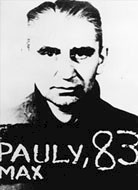
Hans Friedrich Petersen
(1897-1967) was the driver of the Neuengamme concentration camp post office. He drove the truck with the children, their guardians and six of the Soviet prisoners of war who were brought to Bullenhuser Damm. Hans Friedrich Petersen was not charged in the Curio-Haus trials and was not heard as a witness.
He died in Sonderburg, Denmark, in 1967.
Adolf Speck (1911-1946) came to Neuengamme concentration camp as a guard and in the summer of the same year became the commanding officer in the concentration camp's brick factory. He was considered violent. Speck guarded the Soviet prisoners of war together with Wiehagen on the night of the crime. He stated in the Curio-Haus trial that he had shot one of the prisoners because the prisoners had allegedly thrown salt in his face.
He was sentenced to death in May 1946 and executed in October 1946.
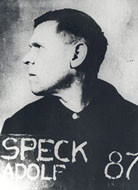
Arnold Strippel (1911-1994) joined the SS in 1934 and subsequently became a guard at Sachsenburg concentration camp. As early as 1938, he became Rapportsführer at Buchenwald concentration camp. Until 1944, Arnold Strippel was deployed in numerous concentration camps, once serving as head of the Ravensbrück satellite camp, Peenemünde-Karlshagen II. Strippel often held leading positions in the National Socialist extermination system. This was also the case in Hamburg, where he was in charge of the SS men who carried out the murders at Bullenhuser Damm.
In 1945, he went into hiding for fear of being punished by British military tribunals and sometimes lived under a false name.
Due to his SS affiliation, he was sent to an internment camp in 1948. As there was not yet enough evidence against him, he was released from detention.
Finally, on June 1, 1949, he was sentenced to life imprisonment by the Frankfurt jury court for the murder of prisoners in the Buchenwald concentration camp. He filed an appeal against the sentence. The sentence was overturned and in 1970 he was only sentenced to 6 years imprisonment for accessory to murder.
He received compensation of 121,500 DM for the over-served prison sentence. He was never sent back to prison after that, although he was sentenced to three years and six months by the Düsseldorf jury court in 1981 for aiding and abetting murder in the Majdanek concentration camp (Poland). He was deemed unfit for imprisonment for health reasons.
In the mid-1960s, the Hamburg public prosecutor's office investigated him for possible involvement in the Bullenhuser Damm murders.
In the Curio-Haus trials, Trzebinski, Dreimann, Jauch and Frahm had accused him of complicity. However, the public prosecutor's office did not feel able to continue the proceedings as they felt there was insufficient evidence.
Following a criminal complaint from relatives of the Bullenhuser Damm victims, the public prosecutor's office resumed the investigation in 1979.
They finally charged him in 1983 with 42 counts of murder of the 20 children, the four prisoner doctors and nurses and the Soviet prisoners of war.
The case was dropped by the Hamburg Regional Court after four years because Strippel was deemed unfit to stand trial for health reasons.
Strippel died in Frankfurt in 1994.

Alfred Trzebinski (1902-1946) joined the SS in 1932 and the NSDAP a year later. He was conscripted into the Wehrmacht in 1939 and after joining the Waffen-SS, he became a camp doctor at Ausschwitz concentration camp in 1941, then at Majdanek concentration camp (Poland). In 1943, Alfred Trzebinski became an SS camp doctor in Neuengamme. He was also involved with the pseudo-medical experiments in the Heißmeyer special unit. Alfred Trzebinski was involved in the murder of the children.
After the end of the war, he went into hiding with his family, but was arrested on February 1, 1946 and sentenced to death in the Curio-Haus trial.
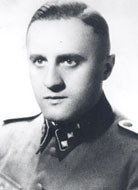
Heinrich Wiehagen
(1911-1945) was a Unterscharführer at Neuengamme concentration camp and helped Wilhelm Dreimann and Johann Frahm to hang the adult prisoners in the boiler room.
In May 1945, he was part of the guard on various ships on which prisoners from Neuengamme concentration camp and survivors of the death march from Fürstengrube concentration camp were taken. The ships in the Bay of Lübeck were accidentally bombed by the Allies because they were not marked as prisoner ships.
Heinrich Wiehagen was beaten to death by prisoners when he shot at other prisoners swimming in the water.